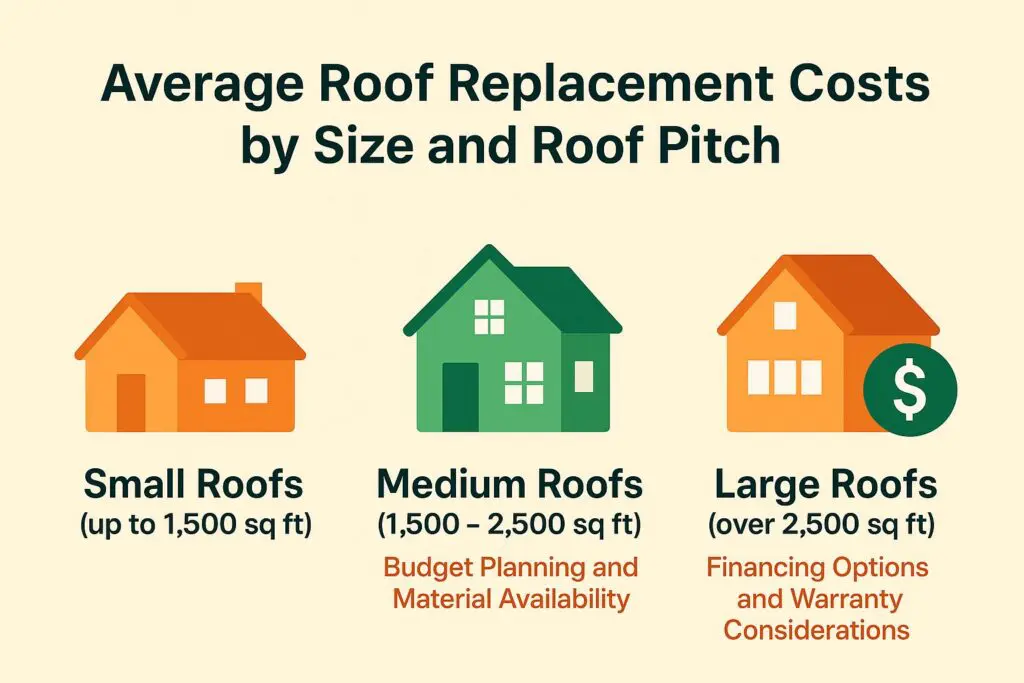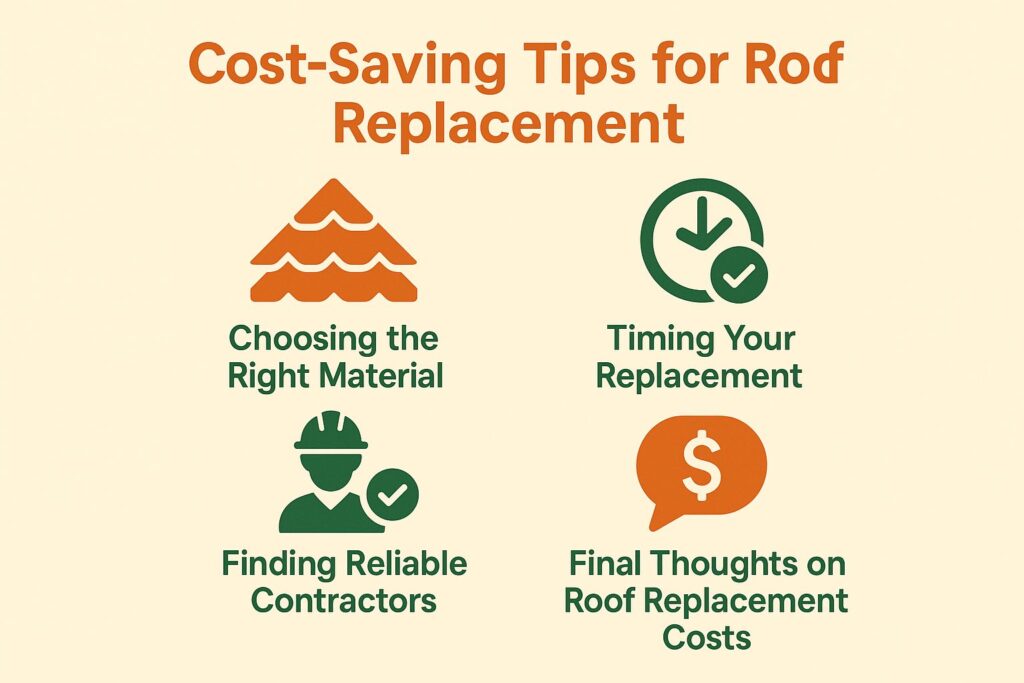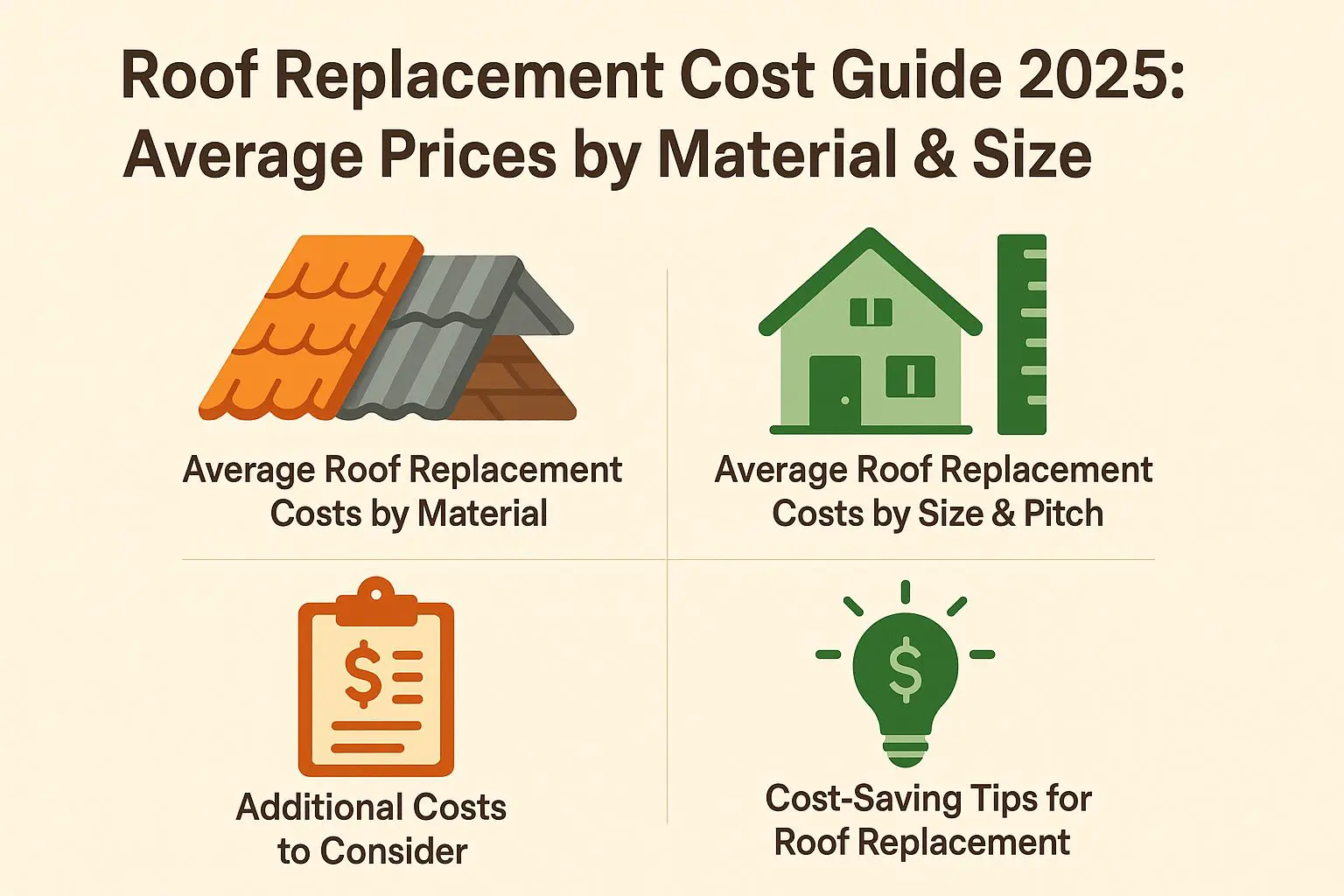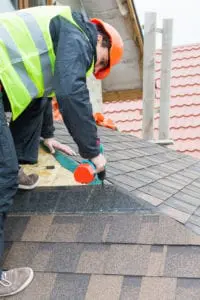Roof Replacement Cost Guide 2025: Average Prices by Material & Size
Roof replacement costs range from $5,000 to $25,000 nationally, with most homeowners paying $8,500 to $16,000 for a complete replacement in 2025. The final cost depends on three main factors: roof size (typically $4-$14 per square foot), material choice (asphalt shingles vs. premium options), and regional labor rates.
1,000-1,500 sq ft
$5,000 – $10,000
1,500-2,500 sq ft
$10,000 – $15,000
2,500+ sq ft
$15,000 – $25,000+
Costs include materials and labor. Premium materials like slate or metal can increase costs significantly.
Understanding roof replacement costs in 2025 helps you budget effectively and avoid unexpected expenses during this major home improvement project. Recent inflation has increased material costs 15-20% since 2023, making accurate pricing information more critical than ever. This comprehensive guide covers pricing by material type, roof size, regional variations, and money-saving strategies to help you make informed decisions.
Quick Navigation
Importance of Understanding Costs
Awareness of roof replacement costs helps in effective budgeting and prevents unexpected financial burdens during home repairs.
To understand the cost of replacing a roof, obtain multiple price quotes from various contractors.
Factors influencing costs include:
- Roof size
- Material (asphalt vs. metal)
- Complexity (single vs. multi-layer)
A standard asphalt roof ranges from $5,000 to $12,000 for an average 1,700 sq ft home, while metal roofs typically cost $12,000 to $25,000. Use online calculators like HomeAdvisor to get basic cost estimates.
Factor in potential long-term savings by investing in energy-efficient materials, which may reduce heating and cooling costs over time. With 2025 energy costs rising, energy-efficient roofing materials can provide 10-20% savings on utility bills. Researching financing options can also alleviate upfront expenses, ensuring you stay within budget.
Factors Influencing Roof Replacement Costs
Different key elements influence the cost of getting a new roof. These include the type of materials used, the size of the roof, and local labor charges, which can differ greatly depending on where you are.
For instance, choosing asphalt shingles may cost between $3,500 and $5,500 for a standard 1,500 square foot home, while metal roofing can range from $8,000 to $12,000.
Labor rates vary significantly by location. For example, roof replacement costs in California and New York average $8-16 per square foot, while states like Alabama and Arkansas average $4-8 per square foot.
To better estimate your expenses, obtain quotes from at least three local contractors, and consider scheduling the replacement during the off-peak season, typically late fall or early winter, to take advantage of potential discounts.
2025 Roof Replacement Costs by Material Types
The choice of roofing material is the single biggest factor affecting your replacement cost. Here’s how different materials compare in price, lifespan, and value:
Asphalt Shingles
Metal Roofing
Tile Roofing
Slate Roofing
Asphalt Shingles: Cost Per Square Foot Analysis
Asphalt shingles usually have a price range of $100 to $150 per square, which makes them one of the cheapest roofing choices you can find.
These shingles can last between 15 to 30 years, depending on the quality and maintenance.
Architectural shingles cost between $120 and $180 per 100 square feet. They are more wind-resistant and look better. Energy efficiency is also a factor; opting for reflective shingles can reduce cooling costs in warm climates.
Tools like the GAF Energy Guide help homeowners figure out their potential energy savings, making it easier to choose the right roofing.
Choosing the right type of shingle can significantly impact long-term costs and efficiency.
Metal Roofing: Considerations and Costs
Metal roofing can range from $300 to $700 per square, offering durability and an average lifespan of 40-70 years.
These roofs last a long time and help save energy by reflecting sunlight, which lowers cooling expenses.
Homeowners often see a return on investment because their property’s value goes up; research indicates that metal roofs can raise resale prices by as much as 6%.
Consider energy-efficient options like cool metal roofing, which can lower energy bills by up to 20%. As mentioned in our detailed guide on metal roof replacement costs, understanding these savings can be crucial for budgeting.
A metal roof is a solid choice for people looking for a strong and eco-friendly solution that doesn’t need much upkeep.
Tile Roofing: Aesthetic and Structural Considerations
Tile roofing, known for its aesthetic appeal, costs approximately $600 to $1,200 per square and can last over 50 years.
Choosing tile roofs improves the look of your home and provides long-lasting benefits and better energy savings.
Compared to asphalt shingles, which last 15-30 years and cost $100-$300 per square, tile roofs often provide better resale value due to their durability. They excel in energy efficiency since they can reduce cooling costs by reflecting sunlight.
Homeowners often report a decrease in energy bills of 20-30% after installation. Although tile roofs are more expensive initially, they can save money in the long run and increase the property’s value, making them a good choice.
Wood Shingles and Shakes: Maintenance and Climate Impact
Wood shingles and shakes generally range from $450 to $700 per square, requiring more maintenance but offering a unique charm to homes.
Wood roofing can greatly improve the look of your home, helping it to be noticed in the neighborhood.
You should clean debris off your roof and treat the shingles every 3-5 years to prevent rotting.
Consider using products like Defy Extreme Wood Stain for protection.
Be aware that while the initial investment is higher compared to asphalt, wood provides better insulation, potentially resulting in energy savings that can offset maintenance costs over time.
Slate Roofing: Investment Value and Resale Value
Slate roofing is one of the most expensive options, costing between $800 to $1,500 per square, but it boasts exceptional durability and longevity.
The expensive nature of slate roofing comes from obtaining the material. Quality slate is often mined in places like France or Spain, which makes transportation expensive.
Setting up everything takes a lot of work and needs experienced workers to make sure all parts are installed and sealed correctly. Even though it costs more at first, slate roofing greatly increases the worth of a home.
Many homeowners find that houses with slate roofs can sell for up to 15% more than similar homes with asphalt roofs, which makes it a wise long-term financial decision.
Rubber Roofing: Eco-Friendly Materials and Energy Efficiency
Rubber roofing typically costs around $300 to $800 per square and is known for its eco-friendliness and high durability.
One key advantage of rubber roofing is its longevity, with an expected lifespan of up to 50 years, significantly outpacing traditional materials like asphalt.
Environmentally, rubber roofing is often made from recycled materials, reducing landfill waste.
Think about possible downsides; starting expenses might be more than other options, and setup needs a professional for best results.
In terms of sustainability, it can be a strong choice, particularly in urban settings, where heat absorption can be reduced, aiding in energy conservation.
Regional Cost Variations Across the United States
Roof replacement costs vary significantly by region due to local labor rates, material availability, and building code requirements. Here’s how costs compare across different areas:
🏙️ High-Cost Regions
🏘️ Moderate-Cost Regions
🏡 Lower-Cost Regions
2025 Roof Replacement Costs by Size and Roof Pitch
The size of your roof is very important because it affects how much you will pay for materials and labor when replacing it. This is one of several factors impacting costs, as detailed in our guide to 8 Factors That Affect the Cost of a New Roof.

Small Roofs (up to 1,500 sq ft)
For small roofs, replacement costs can range from $5,000 to $10,000, depending on material choice, roofing pitch, and the complexity of the installation.
To keep costs down, consider using asphalt shingles, which are among the most affordable options at approximately $90 to $100 per square.
Metal roofing is slightly more expensive, starting at around $200 per square, but offers durability and energy efficiency that can save money long-term.
Another cost-effective choice is rubber roofing, especially for flat roofs, costing about $140 per square.
When planning your project, also account for labor, which can add 50% to the total price.
By carefully selecting materials, you can achieve a balance between upfront costs and longevity.
Medium Roofs (1,500 – 2,500 sq ft): Budget Planning and Material Availability
Medium roofs generally see costs between $10,000 and $15,000, factoring in both materials and labor costs.
The choice of roofing material significantly influences this cost range. Asphalt shingles are one of the cheapest options, usually priced between $100 and $150 per square, which makes them a good choice for homeowners looking to save money.
Alternatively, metal roofing, while pricier at $300 to $700 per square, offers durability and longevity, often exceeding 50 years. For a reasonably priced option, consider architectural shingles. They balance cost and appearance, costing $150 to $250 per square.
When budgeting, remember to account for labor, which can range from $2.50 to $5.00 per square foot, depending on the complexity of the installation.
Large Roofs (over 2,500 sq ft): Financing Options and Warranty Considerations
Large roofs often cost upwards of $15,000, with expenses rising based on selected materials and roof complexity.
Pricing structures for large roofs can vary significantly. For instance, asphalt shingles generally range from $3.50 to $5.50 per square foot, while metal roofs can cost between $7 and $15 per square foot.
Labor typically adds an additional $1 to $3 per square foot. To save money, look into bulk purchase discounts-many suppliers give 10-20% off for large orders.
Scheduling work during off-peak seasons can lead to further savings as contractors may lower their rates to secure jobs.
Additional Costs to Consider
Besides material costs, many other things add to the total cost of replacing a roof, including labor, permits, removal fees, and roof inspection.

Labor Costs
Labor costs for roof replacement can account for 30-50% of the total project cost, varying by region and contractor experience.
To effectively manage these costs, research local rates by obtaining quotes from at least three contractors. For instance, platforms such as HomeAdvisor or Angie’s List can give you information on typical labor costs in your region.
Think about the contractor’s background; experienced workers might cost more but usually provide better results. To further reduce expenses, negotiate the scope of work or schedule the replacement during the off-season, when labor demand typically decreases, allowing for more competitive bidding.
Building Permits and Inspection Costs: Learning About Local Rules and Changes Throughout the Year
Depending on your location and geographical price variations, permits and inspection fees can add an additional $200 to $1,500 to your residential roofing replacement costs.
To handle local rules successfully, begin by looking into your city or town’s specific rules. This may involve checking online resources for building codes or contacting your local building department directly for permit costs.
For example, in Miami, a roof replacement permit costs around $300, while in Los Angeles, it can reach $600. Consulting a licensed roofing contractor can also expedite this process; they often have the latest information on local permits and may include these costs in their project estimates.
Remember that getting the necessary permits makes sure your project follows safety regulations and zoning laws.
Old Roof Removal
Removing an old roof can cost between $1,000 and $2,000, depending on the materials and size of the roof, including tear-off costs.
To budget effectively for roof removal, consider additional factors such as disposal fees-often $100 to $300-and any necessary permits which may range from $50 to $200, along with geographical price variations.
Hiring a contractor can make the process easier, as they will take care of managing waste and labor expenses effectively. Ask different contractors for quotes to compare prices. Look at customer feedback and quality scores. Websites such as HomeAdvisor or Angie’s List are very useful for locating trustworthy local experts.
Preparing for unexpected expenses during roofing projects and considering contractor warranties can save money and prevent project overruns.
Underlayment and Insulation
Installing underlayment and insulation can add an extra $300 to $1,500 to your roof replacement costs, significantly impacting energy efficiency and ventilation systems.
These materials provide a barrier against heat loss, improving your home’s overall energy performance. For instance, using a radiant barrier insulation can reflect heat away during summer, leading to a potential 10-15% decrease in cooling costs and contribute to green roofing options.
High-quality underlayment protects against moisture intrusion, which can save you from expensive repairs down the line. Buying products like ice and water shield underlayment might increase initial expenses, but it protects your roof, prolongs roofing lifespan, and helps save energy over time.
Getting Insurance to Cover Your Roof Replacement
Many homeowners don’t realize that insurance may cover roof replacement costs if the damage is from a covered peril. Here’s what you need to know:
✅ Typically Covered
- Hail damage – Dents, cracks, granule loss
- Wind damage – Blown off shingles, structural damage
- Fire damage – From wildfires or house fires
- Falling objects – Trees, debris, aircraft
- Weight of snow/ice – Structural damage from load
❌ Usually NOT Covered
- Normal wear and tear – Age-related deterioration
- Maintenance issues – Neglect, poor upkeep
- Cosmetic damage – Staining, fading
- Poor installation – Contractor workmanship
- Flood damage – Requires separate flood insurance
📋 Steps to File a Successful Claim
- Document damage immediately – Take photos from multiple angles
- Contact your insurance company – File claim within 1-2 days if possible
- Get professional inspection – Hire a contractor to assess damage
- Meet with adjuster – Be present during their inspection
- Get multiple estimates – Compare contractor quotes with adjuster’s estimate
- Keep all receipts – Document temporary repairs and related expenses
Cost-Saving Tips for Roof Replacement
Using effective strategies to manage project scope and reduce expenses can decrease the overall cost of replacing your roof while maintaining quality. If you’re interested in understanding the complexities of roofing costs, our comprehensive overview on how much roof replacement really costs provides valuable insights.

Choosing the Right Material
Selecting the right roofing material that balances cost and durability can lead to significant savings in the long run, especially when considering aesthetic considerations.
Think about materials like asphalt shingles, which usually cost between $90 to $100 per square and last around 20-30 years, making them perfect for home roofs.
Metal roofing, priced at roughly $300 per square, is a long-lasting choice that can endure for 50 years or longer. While the initial cost is higher, it offers lasting value and reflects current roofing innovations.
If you’re focused on sustainability, slate tiles, while pricier at around $600 per square, can last a century and are fire-resistant, contributing to green roofing options.
Evaluate your local climate and check for any available rebates and tax incentives to maximize your budget effectively.
Timing Your Replacement
Timing your roof replacement during off-peak seasons can save you up to 20% on labor and materials, reflecting seasonal pricing trends.
The best times for roof replacement are late fall and early spring, as homeowners typically delay projects during colder months. During these times, contractors may offer discounts to secure work before peak season, influenced by market trends.
For example, if you replace your roof in October or March, you can often negotiate lower costs. By scheduling in late fall, you can benefit from reduced prices on materials as suppliers clear out inventory and offer vendor negotiations.
Always obtain multiple quotes to compare pricing and look for early booking specials, ensuring detailed analysis of price comparisons.
Best Time to Replace Your Roof: Seasonal Cost Analysis
Strategic timing can save you 10-25% on your roof replacement project. Here’s how costs and conditions vary throughout the year:
❄️ Winter (Dec-Feb)
Cons: Weather delays possible, limited daylight
🌸 Spring (Mar-May)
Cons: Booking up fast, prices rising
☀️ Summer (Jun-Aug)
Cons: Highest prices, long wait times
🍂 Fall (Sep-Nov)
Cons: Popular timing, moderate availability
📅 Optimal Scheduling Strategy
Schedule for early spring installation
Unless it’s an emergency repair
Book 2-3 months in advance
Finding Reliable Contractors
Doing detailed research to find dependable roofing contractors can help you get better prices and good service, emphasizing contractor selection.
Start by reading online reviews on platforms like Yelp and HomeAdvisor to understand contractors’ reputations from customer feedback.
Ask for quotes from at least three contractors to compare pricing and services. Make sure each contractor has up-to-date licenses and insurance to avoid liability.
Request references from past clients and follow up on their experiences, enhancing consumer guides.
By carefully checking potential contractors, you can reduce expenses and guarantee good quality work on your roofing project through effective project management.
Frequently Asked Questions About Roof Replacement Costs
For a typical 1,500 square foot house, roof replacement costs range from $7,500 to $15,000 depending on materials:
- Asphalt shingles: $7,500 – $9,000
- Architectural shingles: $9,000 – $12,000
- Metal roofing: $12,000 – $18,000
These prices include materials, labor, permits, and old roof removal.
The roofing materials themselves are typically the most expensive component, accounting for 40-50% of total costs. Labor comes second at 30-40%, followed by:
- Old roof removal and disposal (10-15%)
- Permits and inspections (2-5%)
- Additional materials (underlayment, flashing) (5-10%)
Late fall through early spring (October-March) typically offers the best savings:
- Labor savings: 10-20% lower rates during off-season
- Material discounts: Suppliers clear inventory
- Better availability: Easier to schedule contractors
Avoid summer months when demand and prices peak.
Insurance typically covers roof replacement if damage is from a covered peril such as:
- Hail or wind damage
- Fire damage
- Falling trees or debris
Age-related wear is usually not covered. If you have storm damage, file a claim quickly and get a professional inspection to document damage.
Most roof replacements take 1-5 days depending on:
- Size: 1,000 sq ft = 1-2 days, 3,000 sq ft = 3-5 days
- Complexity: Multiple levels, chimneys, or skylights add time
- Weather: Rain or high winds can cause delays
- Material: Slate and tile take longer than asphalt
Planning and permitting can take 1-4 weeks before work begins.
Need a personalized estimate? Get free quotes from licensed contractors in your area.
Time to Update Your Home’s Roof? Get Started Today With Free Quotes From Roofers In Your City
Looking at all the factors that influence roof replacement prices, such as economic predictions, helps you make choices that raise the value of your home.
Start by evaluating your current roof’s condition, materials used, potential upgrades, and roofing accessories. For instance, opting for asphalt shingles may cost around $3-$5 per square foot, whereas metal roofing could range from $7-$12 per square foot, yielding better durability.
Consider seasonal timing carefully – with 2025 material costs at historic highs, booking during winter months (December-February) can save 15-25% on both labor and materials compared to peak summer pricing. Research local contractors through platforms like Angie’s List or HomeAdvisor to compare prices and reviews, facilitating local market analysis.
Don’t forget to check for available permits and local regulations, ensuring adherence to safety regulations. Don’t wait until emergency repairs become necessary. Get free quotes from licensed contractors today to lock in 2025 pricing before spring demand drives costs higher.
🏡 Pro Tip
A roof that looks fine from the ground can still be failing underneath. Soft spots or sagging areas in the decking are strong indicators that the roof system has been compromised and should be professionally replaced.
— Daniel Ruiz, Project Manager at Ironclad Exteriors — San Antonio, TX
📈 How We Collected Roofing Cost Data
The pricing estimates in this guide are based on a combination of nationally recognized construction cost databases, labor data, and real-world material pricing.
Construction Cost Data:
We used RSMeans data from Gordian™, one of the most trusted construction cost databases in the industry. RSMeans is relied upon by thousands of contractors, estimators, and developers nationwide to accurately price construction projects.
Source: https://www.rsmeans.com/
Labor Costs:
Labor pricing was informed by current roofer wage data, including average salaries reported on Indeed.com, with regional adjustments applied where applicable.
Sources: https://www.indeed.com/career/roofer/salaries, https://www.ziprecruiter.com/Salaries/Roofer-Salary
Material Costs:
Our research team analyzed roofing material pricing from multiple major suppliers within a 30-mile service radius to reflect realistic contractor costs. This included asphalt shingles and related materials from leading manufacturers and distributors.
Sources:
- https://www.homedepot.com/b/Building-Materials-Roofing/N-5yc1vZaq7m
- https://www.lowes.com/pl/roofing/roof-shingles/4294524358
To further validate our estimates, we cross-referenced this information with data from the U.S. Census Bureau and additional industry reports.
If you have questions, feedback, or would like clarification on any part of this guide, please contact our team at info@bestroofingestimates.com.






